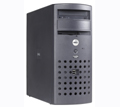New server: Dell PowerEdge SC420
On January 28, I received my new server from Dell. Here are the main features of this machine:
- Model: PowerEdge SC420
- Processor: Celeron 2.53 GHz
- Hard Disk: 80GB SATA
- RAM: 512 MB, DDR2, 400 MHz
- CDROM: 48X
- Network: Onboard Gigabit Ethernet

I had been looking for a computer to run as my linux server for a while. I needed something that would run 24 hours a day and be quiet enough to be housed in my study room. Previously, I had used a fanless 533 MHz machine as my file and mail server, network router and for general purpose software development. This was meant to be its replacement.I have divided this review by criteria
Price
This may sound fishy, but the server cost was only $299, taxes and shipping included! Simply go to Dell’s website and select Poweredge SC420 with the bare minimums. Apparently, they had a special couple months ago which allowed you to own the system for an even lower price of $229. But I missed the opportunity by two weeks.
Processing Power
This is somewhat dependent on the software that you plan to run on this machine. If you want to play the latest 3D games in Windows, then forget it. This computer was not designed for gamers. It has a very basic VGA graphics and no built-in sound capability. If you use the sytem as your desktop, it may run fine. My goal was to have a file and mail server running on linux. For this purpose, it is overkill. The average CPU use is less than 0.1%. SC420 would make a solid mail or DNS server for a medium sized company. Why spend thousands when you can have this. You may not be able to brag to your friends about the specs, but it does the job well.
Noise
If you have had prior experience with server class machines, the first thing that probably comes to your mind is noise. Well, I am glad to say that the Dell Poweredge SC420 with Celeron processor does not suffer from this ailment. The CPU runs cool enough so that the fan does not have to spin at hyper-speeds. I have been told that the Pentium 4 version is considerably louder. In a silent room, it is barely audible. In fact, it runs quieter than many desktops I have encountered in the past.
Construction
I really like the fact that there are no screws anywhere in the box. You can open the box (as seen in the picture) and replace PCI cards without ever needing a screwdriver. In addition to this, the inside is not cramped at all. The biggest obstacle of any kind is the CPU heatsink. It is huge! It looks like a Borg cube. The chassis fan is right next to it which makes things efficient. The SATA cable really helps keep the interior neat and tidy. Now only if Dell could get rid of the IDE ribbon cable running to the CDROM drive.
Expandability
As mentioned before, the motherboard does not have onboard sound. But it does have gigabit ethernet. For adding other things, you have three PCI slots, one PCIe x1 and one PCIe x8 slot. There are a lot of USB 2.0 ports available as well – both on the front panel and on the back.
Linux Support
I installed Fedora Core 2 from CDs. It had drivers for everything except the gigabit ethernet chip. I needed to download the driver from Broadcom’s website which I did using the second ethernet card I had installed (this system acts as a router as well, hence two NICs). The chip is a Broadcom BCM5751. If you install Fedora Core 3, it already has this driver.
root@europa$ cat /proc/cpuinfo
processor : 0
vendor_id : GenuineIntel
cpu family : 15
model : 4
model name : Intel(R) Celeron(R) CPU 2.53GHz
stepping : 1
cpu MHz : 2527.451
cache size : 256 KB
fdiv_bug : no
hlt_bug : no
f00f_bug : no
coma_bug : no
fpu : yes
fpu_exception : yes
cpuid level : 3
wp : yes
flags : fpu vme de pse tsc msr pae mce cx8 apic mtrr pge mca cmov pat
pse36 clflush dts acpi mmx fxsr sse sse2 ss ht tm pbe pni monitor
ds_cpl est cid
bogomips : 5013.50
root@europa$ lspci
00:00.0 Host bridge: Intel Corp. Server Memory Controller Hub (rev 04)
00:01.0 PCI bridge: Intel Corp. Server Memory Controller Hub PCI Express Port (rev 04)
00:02.0 VGA compatible controller: Intel Corp. Graphics Controller (rev 04)
00:1c.0 PCI bridge: Intel Corp. I/O Controller Hub PCI Express Port 0 (rev 03)
00:1c.1 PCI bridge: Intel Corp. I/O Controller Hub PCI Express Port 1 (rev 03)
00:1d.0 USB Controller: Intel Corp. I/O Controller Hub USB (rev 03)
00:1d.1 USB Controller: Intel Corp. I/O Controller Hub USB (rev 03)
00:1d.2 USB Controller: Intel Corp. I/O Controller Hub USB (rev 03)
00:1d.3 USB Controller: Intel Corp. I/O Controller Hub USB (rev 03)
00:1d.7 USB Controller: Intel Corp. I/O Controller Hub USB2 (rev 03)
00:1e.0 PCI bridge: Intel Corp. 82801BA/CA/DB/EB/ER Hub interface to PCI Bridge (rev d3)
00:1f.0 ISA bridge: Intel Corp. I/O Controller Hub LPC (rev 03)
00:1f.1 IDE interface: Intel Corp. I/O Controller Hub PATA (rev 03)
00:1f.2 IDE interface: Intel Corp. I/O Controller Hub SATA cc=raid (rev 03)
00:1f.3 SMBus: Intel Corp. I/O Controller Hub SMBus (rev 03)
02:00.0 Ethernet controller: Broadcom Corporation: Unknown device 1677 (rev 01)
04:02.0 Ethernet controller: Winbond Electronics Corp W89C940
root@europa$ cat /proc/scsi/scsi
Attached devices:
Host: scsi0 Channel: 00 Id: 00 Lun: 00
Vendor: ATA Model: WDC WD800JD-75JN Rev: 1.02
Type: Direct-Access ANSI SCSI revision: 05
